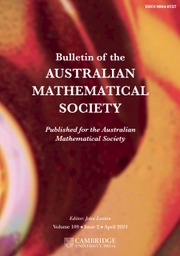No CrossRef data available.
Article contents
SUMMABILITY AND ASYMPTOTICS OF POSITIVE SOLUTIONS OF AN EQUATION OF WOLFF TYPE
Published online by Cambridge University Press: 14 May 2024
Abstract
We use potential analysis to study the properties of positive solutions of a discrete Wolff-type equation  $$ \begin{align*} w(i)=W_{\beta,\gamma}(w^q)(i), \quad i \in \mathbb{Z}^n. \end{align*} $$
$$ \begin{align*} w(i)=W_{\beta,\gamma}(w^q)(i), \quad i \in \mathbb{Z}^n. \end{align*} $$
Here,  $n \geq 1$,
$n \geq 1$,  $\min \{q,\beta \}>0$,
$\min \{q,\beta \}>0$,  $1<\gamma \leq 2$ and
$1<\gamma \leq 2$ and  $\beta \gamma <n$. Such an equation can be used to study nonlinear problems on graphs appearing in the study of crystal lattices, neural networks and other discrete models. We use the method of regularity lifting to obtain an optimal summability of positive solutions of the equation. From this result, we obtain the decay rate of
$\beta \gamma <n$. Such an equation can be used to study nonlinear problems on graphs appearing in the study of crystal lattices, neural networks and other discrete models. We use the method of regularity lifting to obtain an optimal summability of positive solutions of the equation. From this result, we obtain the decay rate of  $w(i)$ when
$w(i)$ when  $|i| \to \infty $.
$|i| \to \infty $.
MSC classification
- Type
- Research Article
- Information
- Bulletin of the Australian Mathematical Society , Volume 110 , Issue 3 , December 2024 , pp. 535 - 544
- Copyright
- © The Author(s), 2024. Published by Cambridge University Press on behalf of Australian Mathematical Publishing Association Inc.



